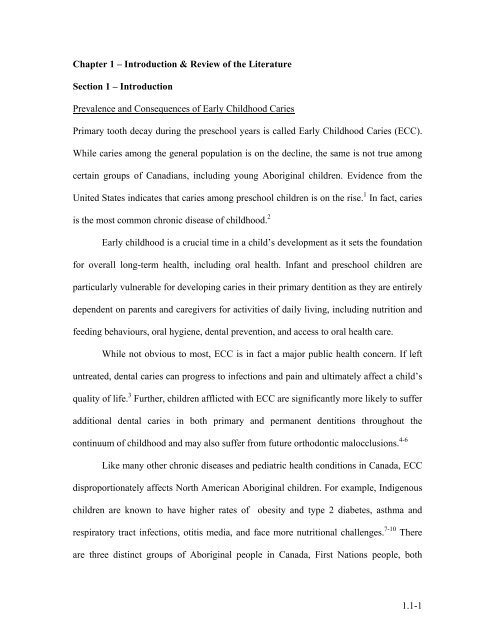Influence of Maternal Prenatal Vitamin D Status on Infant Oral Health
Influence of Maternal Prenatal Vitamin D Status on Infant Oral Health
Influence of Maternal Prenatal Vitamin D Status on Infant Oral Health
Create successful ePaper yourself
Turn your PDF publications into a flip-book with our unique Google optimized e-Paper software.
Chapter 1 – Introducti<strong>on</strong> & Review <str<strong>on</strong>g>of</str<strong>on</strong>g> the Literature<br />
Secti<strong>on</strong> 1 – Introducti<strong>on</strong><br />
Prevalence and C<strong>on</strong>sequences <str<strong>on</strong>g>of</str<strong>on</strong>g> Early Childhood Caries<br />
Primary tooth decay during the preschool years is called Early Childhood Caries (ECC).<br />
While caries am<strong>on</strong>g the general populati<strong>on</strong> is <strong>on</strong> the decline, the same is not true am<strong>on</strong>g<br />
certain groups <str<strong>on</strong>g>of</str<strong>on</strong>g> Canadians, including young Aboriginal children. Evidence from the<br />
United States indicates that caries am<strong>on</strong>g preschool children is <strong>on</strong> the rise. 1 In fact, caries<br />
is the most comm<strong>on</strong> chr<strong>on</strong>ic disease <str<strong>on</strong>g>of</str<strong>on</strong>g> childhood. 2<br />
Early childhood is a crucial time in a child’s development as it sets the foundati<strong>on</strong><br />
for overall l<strong>on</strong>g-term health, including oral health. <strong>Infant</strong> and preschool children are<br />
particularly vulnerable for developing caries in their primary dentiti<strong>on</strong> as they are entirely<br />
dependent <strong>on</strong> parents and caregivers for activities <str<strong>on</strong>g>of</str<strong>on</strong>g> daily living, including nutriti<strong>on</strong> and<br />
feeding behaviours, oral hygiene, dental preventi<strong>on</strong>, and access to oral health care.<br />
While not obvious to most, ECC is in fact a major public health c<strong>on</strong>cern. If left<br />
untreated, dental caries can progress to infecti<strong>on</strong>s and pain and ultimately affect a child’s<br />
quality <str<strong>on</strong>g>of</str<strong>on</strong>g> life. 3 Further, children afflicted with ECC are significantly more likely to suffer<br />
additi<strong>on</strong>al dental caries in both primary and permanent dentiti<strong>on</strong>s throughout the<br />
c<strong>on</strong>tinuum <str<strong>on</strong>g>of</str<strong>on</strong>g> childhood and may also suffer from future orthod<strong>on</strong>tic malocclusi<strong>on</strong>s. 4-6<br />
Like many other chr<strong>on</strong>ic diseases and pediatric health c<strong>on</strong>diti<strong>on</strong>s in Canada, ECC<br />
disproporti<strong>on</strong>ately affects North American Aboriginal children. For example, Indigenous<br />
children are known to have higher rates <str<strong>on</strong>g>of</str<strong>on</strong>g> obesity and type 2 diabetes, asthma and<br />
respiratory tract infecti<strong>on</strong>s, otitis media, and face more nutriti<strong>on</strong>al challenges. 7-10 There<br />
are three distinct groups <str<strong>on</strong>g>of</str<strong>on</strong>g> Aboriginal people in Canada, First Nati<strong>on</strong>s people, both<br />
1.1-1







![an unusual bacterial isolate from in partial fulf]lment for the ... - MSpace](https://img.yumpu.com/21942008/1/190x245/an-unusual-bacterial-isolate-from-in-partial-fulflment-for-the-mspace.jpg?quality=85)





![in partial fulfil]ment of the - MSpace - University of Manitoba](https://img.yumpu.com/21941988/1/190x245/in-partial-fulfilment-of-the-mspace-university-of-manitoba.jpg?quality=85)


